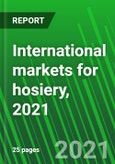World Trade in Socks, Pantyhose, Tights, Compression Hosiery and Stockings is Expected to Rebound in 2021 But Growth Looks Sluggish in 2022 and Beyond
This report provides vital data and analysis of trends in international trade in hosiery. The report focuses in detail on the leading hosiery exporting and importing countries, including those which export hosiery to the EU and the USA. Countries analysed in the report include China, Italy, Pakistan, Serbia, Turkey and the USA. Of these countries, the world's top hosiery exporting country in 2020 was China. However, its share of global hosiery exports was down from the previous year to their lowest level since 2010.
According to the latest data, global imports and exports of hosiery fell in 2020. In fact, global exports of hosiery fell to their lowest level since 2010, reflecting the impact of the COVID-19 pandemic. EU imports of hosiery declined in value and in volume terms in 2020 as did US imports of hosiery, which fell to their lowest level since 2011.
Table of Contents
SUMMARY
GENERAL TRENDS IN HOSIERY TRADE
- Outlook
LEADING HOSIERY EXPORTING COUNTRIES
LEADING HOSIERY IMPORTING COUNTRIES
IMPORTS OF HOSIERY INTO THE EU
- General trends
- EU imports of hosiery by fibre type
- EU imports of hosiery by leading supplier
IMPORTS OF HOSIERY INTO THE USA
- General trends
- US imports of hosiery by fibre type
- US imports of hosiery by leading supplier
List of Tables
Table 1: Exports of hosiery by type, 2010-20
Table 2: Imports of hosiery by type, 2010-20
Table 3: Exports of hosiery by leading supplier, 2010-20
Table 4: Imports of hosiery by leading destination, 2010-20
Table 5: EU: imports of hosiery by fibre type, 2010-20
Table 6: EU: imports of hosiery by leading supplier, 2010-20
Table 7: USA: imports of hosiery by fibre type, 2010-20
Table 8: USA: imports of hosiery by leading supplier, 2010-20
Executive Summary
World trade in hosiery, including socks, pantyhose, tights, compression hosiery and stockings, is expected to rebound in 2021, according to the report “International markets for hosiery”. But growth in 2022 and beyond is forecast to return to low single digits. The rebound will follow a 13.7% fall in 2020, when world exports of hosiery fell to their lowest level since 2010. The fall reflected the impact of the COVID-19 pandemic, and there are concerns about the recovery of the market in the coming years as several threats loom.
The prediction for 2022 is based on the assumption that global economic uncertainties will persist--particularly in the EU and the USA, the two main consumer markets for hosiery--as the world economy recovers from the COVID-19 pandemic.
The world economy has also been negatively affected in recent years by protectionist measures--including additional tariffs on US imports from China--and such measures are likely to continue to have a negative impact on trade growth in the coming years.
In the case of hosiery, in particular, the additional tariffs on US imports from China are likely to result in a shift of some Chinese production to lower cost countries in Asia--including Bangladesh, India, Indonesia, Pakistan and Vietnam. Having said that, many of these lower cost countries do not have the infrastructure in place to produce the high volumes which the Chinese industry is capable of producing.
The largest hosiery exporting countries--which include Italy, Turkey and the USA--have historically been relatively high price suppliers. However, exports from many of these countries have declined in recent years as new players located in low cost Asian countries have made significant gains at their expense.
In the case of hosiery imports, growth in the two largest markets--namely the USA and the EU--is likely to be minimal in the coming years as these markets are mature and the economic outlook in these markets is poor. In fact, most of the growth in import markets is expected to occur in emerging markets in Asia, reflecting rapid expansion of the upper and middle classes in a number of countries in the region. As a result, there is expected to be some upheaval resulting from shifts in sourcing trends in the short to medium term and such upheaval could negatively affect world trade as a whole. At the same time, however, it should create opportunities for new players to enter the market.
Opportunities are also expected to arise as a result of the implementation and increasingly widespread use of Industry 4.0 production methods, which will allow for mass customisation and improvements in productivity.
Countries Covered
- China
- Italy
- Pakistan
- Serbia
- Turkey
- USA








